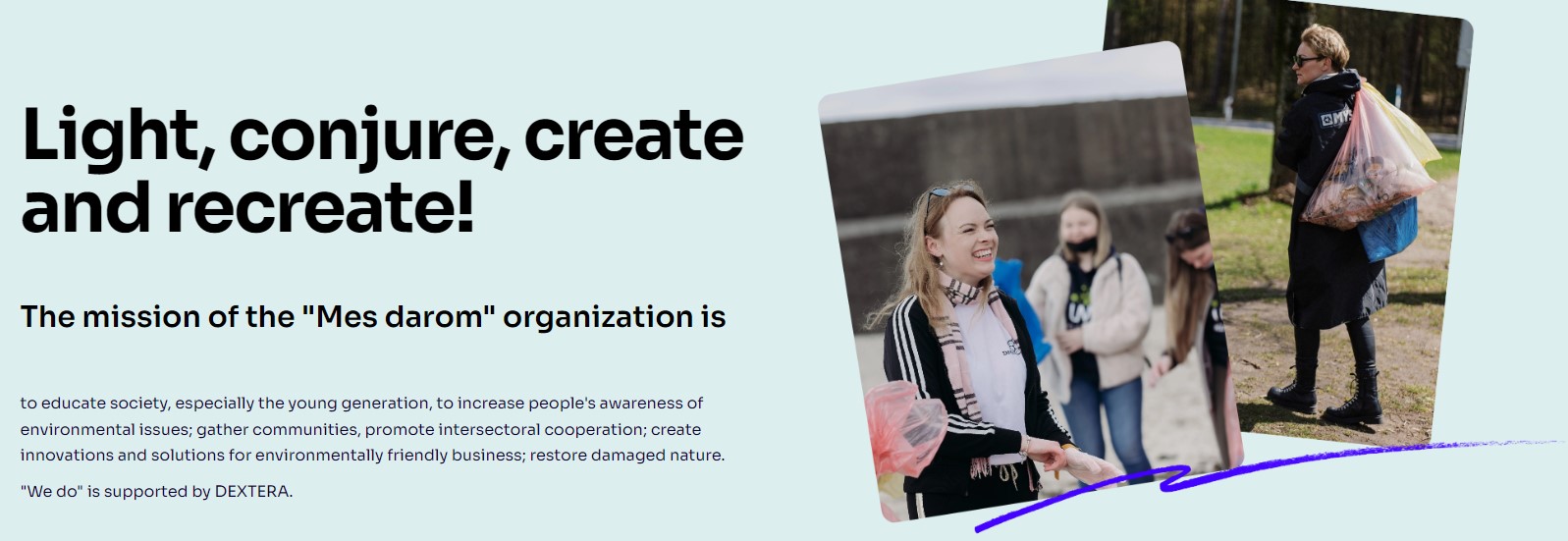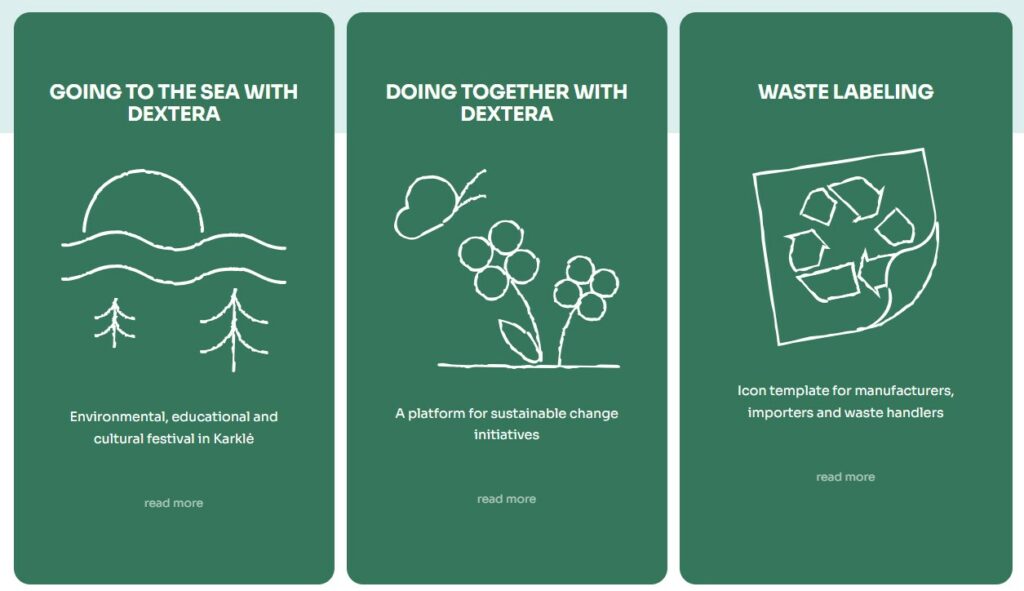
Respect and consideration for the environment and nature. It is important to make citizens aware that the cleanliness and ecology of the environment depends on themselves. DAROM develops the habit of communities to take care about their own environment.
“Darom” is an annual global campaign that collects rubbish throughout Lithuania. The campaign was launched in 2008. The first campaign had ~3000 volunteers. It has become an annual event in Lithuania and attracts more and more enthusiasts for clean nature.
The campaign has been launched in other countries such as Latvia, Slovenia, Portugal, Brazil, India, Russia, Ukraine, Moldova, etc.
The Darom campaign is based on the initiative of volunteers to clean up the environment, but it is also supported by municipal companies and private businesses, which help to transport the collected waste and provide the participants with bags. Before each campaign, collection points are selected online and coordinators are appointed.
Litter picking takes place in the countryside, in parks, woodlands, foothills and other non-urban areas that are rarely serviced by municipal services
- More Info
- Gallery
- Interview
- Contact
Challenge
Respect and consideration for the environment and nature. It is important to make citizens aware that the cleanliness and ecology of the environment depends on themselves. DAROM develops the habit of communities to take care about their own environment.
“Darom” is an annual global campaign that collects rubbish throughout Lithuania. The campaign was launched in 2008. The first campaign had ~3000 volunteers. It has become an annual event in Lithuania and attracts more and more enthusiasts for clean nature.
The campaign has been launched in other countries such as Latvia, Slovenia, Portugal, Brazil, India, Russia, Ukraine, Moldova, etc.
The Darom campaign is based on the initiative of volunteers to clean up the environment, but it is also supported by municipal companies and private businesses, which help to transport the collected waste and provide the participants with bags. Before each campaign, collection points are selected online and coordinators are appointed.
Target group
All members of the communities. Various municipalities invite their community members to participate.
Solution
Strengthen the awareness and responsibility of the whole community for the cleanliness of their surroundings
Innovation
Community volunteering for the cleaner environment
It builds a sense of community and encourages taking responsibility for the environment
Unique Selling Point
Organized meaningful community building action
Impact
This includes all of Lithuania and its citizens, communities. Also, in other EU countries and communities.
Feasibility / Transferability
Easily transferable to any other country in the world

DAROM campaign manager Toma Buivydaitė,
Linkedin: https://www.linkedin.com/in/toma-buivydait%C4%97-1b03b8105/?originalSubdomain=lt
Tel.no. +370 617 87892
E-mail: labas@mesdarom.lt
https://mesdarom.lt

 3 - Good Health & Well-Being
3 - Good Health & Well-Being
By April 2022, the coronavirus causing COVID-19 had infected more than 500 million people and killed more than 6.2 million worldwide. However, the most recent estimates suggest that the global number of excess deaths directly and indirectly attributable to COVID-19 could be as high as three times this figure. The pandemic has severely disrupted essential health services, shortened life expectancy and exacerbated inequities in access to basic health services between countries and people, threatening to undo years of progress in some health areas. Furthermore, immunization coverage dropped for the first time in 10 years and deaths from tuberculosis and malaria increased.
Reproductive, maternal and child health
Based on data from 2015-2021, 84 per cent of births worldwide were assisted by skilled health professionals, including medical doctors, nurses and midwives, an increase from 77% in 2008-2014. In sub-Saharan Africa, coverage is 20 percentage points lower. Available data do not reflect the impact of the COVID-19 pandemic on the disruption of services, which may reverse gains made over the past decades.
The global under-5 mortality rate fell by 14 per cent, from 43 deaths per 1,000 live births in 2015 to 37 deaths per 1,000 live births in 2020, while the global neonatal mortality rate fell to 17 deaths per 1,000 live births in 2020 from 19 deaths per 1,000 live births in 2015, a 12 per cent reduction. Even with that progress, 5 million children died before reaching their fifth birthday in 2020 alone, down from 5.9 million in 2015. Almost half of those deaths, 2.4 million, occurred in the first month of life.
The proportion of women of reproductive age (15-49 years) whose need for family planning was satisfied through use of modern contraceptive methods stagnated at about 77 per cent between 2015 and 2022, while sub-Saharan Africa has seen the largest increase – almost 5 percentage points. The ongoing COVID-19 pandemic may lead to a reversal of this trend because of supply chain disruptions and decreased access to family planning services.
The adolescent birth rate has fallen worldwide from 56 births per 1,000 adolescents aged 15-19 years in 2000 to 45 births in 2015 and 41 births in 2020. The largest declines are occurring in Central and Southern Asia, from 70 births per 1,000 adolescent women in 2000 to 24 births in 2020. Early adolescent childbearing, occuring in the 10–14 age group, is much more common in countries in sub-Saharan Africa and Latin America and the Caribbean than in other parts of the world.

 11 - Sustainable Cities & Communities
11 - Sustainable Cities & Communities
As epicentres of the COVID-19 crisis, many cities have suffered from insufficiencies in public health systems, inadequate basic services, a lack of well-developed and integrated public transport systems and inadequate open public spaces, as well as from the economic consequences of lockdowns. As a result, the pandemic is likely to further increase the number of slum dwellers. In order to improve the lives of over 1 billion slum dwellers, there is an urgent need to focus on policies for improving health, affordable housing, basic services, sustainable mobility and connectivity.
Over the years, the number of slum dwellers has continued to grow and that number was over 1 billion in 2020. Slum dwellers are most prevalent in three regions, which are home to about 85 per cent of the world’s slum residents: Central and Southern Asia (359 million), Eastern and South-Eastern Asia (306 million) and sub-Saharan Africa (230 million).
Data for 2020 from 1,510 cities around the world indicate that on average only about 37 per cent of their urban areas are served by public transport, measured as a walking distance of 500 m to low-capacity transport systems (such as buses and trams) and/or 1,000 m to high-capacity systems (such as trains and ferries). Given variations in population concentrations within those cities, this translates into only about 52 per cent of the world population having convenient access to public transport.
In 2022, the global average municipal solid waste collection rate in cities is at 82 per cent and the global average rate of municipal solid waste management in controlled facilities in cities is at 55 per cent. The municipal solid waste collection rates in sub-Saharan Africa and Oceania are less than 60 per cent. Uncollected waste is the source of plastic pollution, greenhouse gas emissions and incubation for infections.
Data for 2020 from 1,072 cities point to a poor distribution of open public spaces in most regions. In these cities, only about 38 per cent of urban areas are loca ted within a walking distance of 400 m to an open public space, which translates into only about 45 per cent of the global urban population having convenient access to those spaces.
By March 2021, a total of 156 countries had developed national urban policies, with almost half (74) already in the implementation stage. A further breakdown shows that 40 per cent of the countries are in the early stages of developing their plans, while 12 per cent are monitoring and evaluating how well those plans are functioning.
By the end of 2021, a total of 98 countries had reported having local governments with disaster risk reduction strategies, an increase from 51 countries in 2015.

